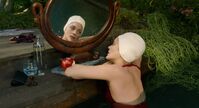The bloodthirsty demon Henry has no way to kill people recklessly in the real world. For this reason, he has to put on the cloak of comedy and humor, make a contract with the audience, and conspire to perform rounds of "violence and killing" feast: the demon provides the audience with relief. Defensive joy, while the audience gratifies demonic desires at the cost of being "murdered". A talk show full of provocation, ridicule and laughter is a bloody crime scene where the murderer and the victim tacitly agree with each other (the constant questioning between the creator and the viewer is the best proof).
One day, the demon falls in love with the benevolent angel Ann who sacrificed herself to redeem the world, who uses opera/tragedy as a holy place to wash and save the fallen souls of mankind (performing "Death" again and again on stage). Killing and devotion, this pair of enemies who should not be on the same level tied the knot because of love. However, marriage and childbirth have become the uncontrollable destructive impulse of the devil, and the fuse of the violent out of control. The secret pact between the demon and the audience via the laugh-provoking talk show was ripped apart because the audience felt that the demon's jokes were no longer funny, and they felt the moral offense and malice that flowed from behind the jokes (really). Is it just a joke? The devil first revealed his strong desire to kill his wife in the public), and this has long been a magic weapon used by the devil to "open the slaughter" to eat flesh and blood. Now facing the anguish of being trapped at home with a daughter, and the overwhelming resistance of the audience who tore up the contract, how can the bloodthirsty and disordered nature of the devil be satisfied?
As a result, on a night of thunderstorms and stormy seas, the demon finally attacked the angel beside him, losing the airtight virtual field of wanton killing (without fear of punishment). The tormented demon pulled the reluctant angel, He danced the dance of death in anticipation of the destructive wind and waves, and then succeeded in carrying out a true murder. The waves are roaring, the turbulent turmoil of the hazy night, a bottomless abyss/vortex that captivates people's hearts slowly rises, the demon showing murderous intent can't resist the temptation, and it plummets like a free fall. Daughter Annette turns to be the only object of exploitation (a creepy puppet) for the demon to re-establish a mutually beneficial complicity with the audience, and the body is endowed with singing talent, and the vengeful angel who turns into a ghost wants to cause the demon to be destroyed. within the plan.
Therefore, the revolving carousel smashed by Annette at the end of the film has a double meaning. On the one hand, the daughter does not want to live as a father (or mother's revenge machine) to build a beautiful illusion in front of others, and to survive as an exploitative tool for fame and fortune; The aspect belongs to Leo Carax's reflexivity in the image: the accompanying work is the original installation with moving images - the myth-busting of the magic lamp, like the use of brisk melodies, brilliant lighting and editing, whitewashing atrocities and murders. Once the image lies are uncovered, there will be nowhere to hide what the devil has done, and the truth will eventually be revealed to the world.
Annette's puppet turned into a real person is also the process of changing from the "dream" of intoxication and weirdness to the naked and cruel "reality" (in the end, the demon was imprisoned by the angry audience), and the daughter responded to the remorseful demon father when visiting the prison " Can't you love me?" The implication is that you will never be loved by anyone except the mother of an angel (the only angel who loves you has been killed by you).
View more about Annette reviews











